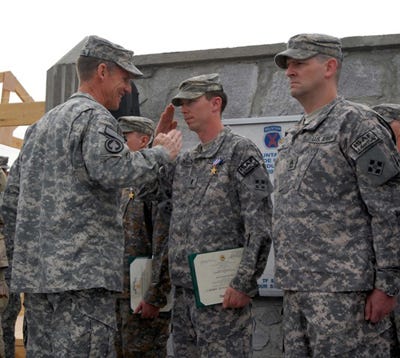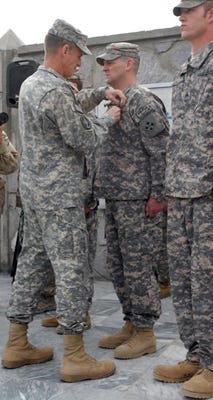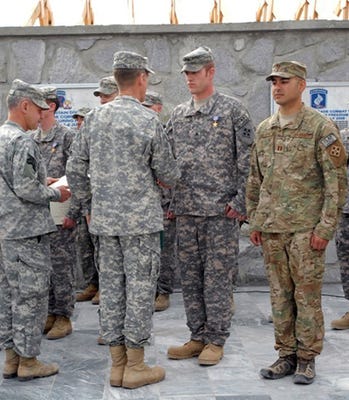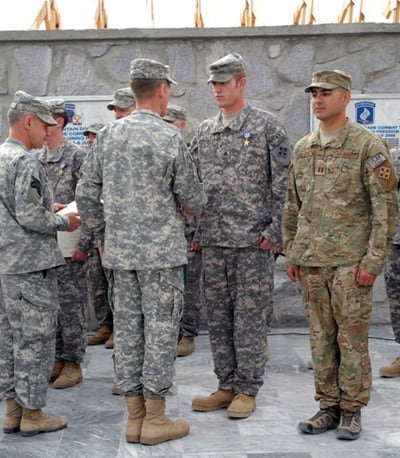source GAIA package: Sx_MilitaryTimes_M6201010004250304_5675.zip Origin key: Sx_MilitaryTimes_M6201010004250304 imported at Fri Jan 8 18:18:03 2016
The fighting began at 6 a.m. Enemy fighters occupying high ground fired a recoilless rifle, rocket-propelled grenades, mortars, machine guns and rifles into all four sides of Combat Outpost Keating.
 The soldiers at the small American and Afghan post in the mountains of Afghanistan's Nuristan province were outnumbered by an enemy force of almost 400.
The soldiers at the small American and Afghan post in the mountains of Afghanistan's Nuristan province were outnumbered by an enemy force of almost 400.
 Almost immediately, the Americans' mortars were pinned down and could not fire.
Almost immediately, the Americans' mortars were pinned down and could not fire.
 The first American soldier was killed within minutes, and in less than an hour, the enemy swarmed the COP, breaching the Afghan army side of the compound, eventually setting fire to the small outpost and destroying almost 70 percent of it.
The first American soldier was killed within minutes, and in less than an hour, the enemy swarmed the COP, breaching the Afghan army side of the compound, eventually setting fire to the small outpost and destroying almost 70 percent of it.
Soldiers from 3rd Squadron, 61st Cavalry Regiment, 4th Brigade Combat Team, 4th Infantry Division, fought back valiantly, killing an estimated 100 enemy fighters. But the soldiers suffered heavy losses. Eight of their own were killed, and 24 others wounded on Oct. 3 in one of the deadliest battles since the start of the war in Afghanistan.
On April 9, four of the Americans were awarded the Silver Star, the third highest award for valor, for their actions in the battle. At least four other Silver Star nominations are pending approval.
The Silver Stars were awarded to Capt. Christopher Cordova, 1st Lt. Andrew Bundermann, Sgt. 1st Class Jonathan Hill and Sgt. Thomas Rasmussen. Details from the narratives that accompany the awards paint a harrowing picture of what happened that day in northeast Afghanistan.
In the first minutes of the attack, the COP's main generator was destroyed, cutting off power to most of the post. During the first three hours, enemy mortars hit the COP and nearby Observation Post Fritsche every 15 seconds. RPGs hit all six of the unit's Humvees.
First casualties
Soldiers were hit almost immediately, and within minutes, the first casualty was brought into the aid station, where power was out. Cordova, the squadron's physician assistant, set up the aid station for mass casualties.
When the first wounded soldier was brought in, Cordova frantically worked to stop the profuse bleeding from the soldier's skull as enemy bullets bounced off the aid station's exterior walls.
As Cordova worked, five wounded Afghan soldiers and another American who had suffered a gunshot wound to the chest were brought in. As the minutes ticked by, more wounded came into the aid station.
At one point, Cordova was managing medical care for five Americans and seven Afghans, treating gunshot wounds, head injuries, shrapnel wounds, chest and abdominal wounds, eye injuries and broken legs.
While Cordova was dealing with the wounded, Rasmussen was fighting back. With RPGs, mortars and bullets raining down from all directions, Rasmussen ran to a Humvee and began linking .50-caliber ammunition to allow the gunner to keep suppressing enemy fighters to the north of the outpost. Intent on stopping the .50-cal machine gun, enemy fighters rained mortars and small-arms fire onto the truck. Undaunted, Rasmussen clambered on top of the truck and continued fighting even after he was knocked off his feet by an RPG that struck the front of the Humvee.
When the .50-cal ran low on ammunition, Rasmussen ran back to the barracks under heavy fire to get more. There he found a wounded soldier and began administering first aid. Another sergeant was sent out to the Humvee, and Rasmussen was tasked to be the point man for an assault team preparing to reinforce fighting positions.
Counterattacks
On another side of the COP, with his platoon leader away, Hill rallied his troops from 3rd Platoon and directed them in counterattacks. As he organized his soldiers to resupply embattled guard positions, Hill suffered multiple shrapnel wounds from RPG fire but pushed forward. He ignored his own wounds and administered first aid to several soldiers who also received shrapnel wounds.
By this time, the enemy had infiltrated and set the east side of the outpost on fire.
Hill directed a team of soldiers to clear the area and begin setting up a new perimeter. When Hill and his soldiers came under accurate sniper fire, Hill "without hesitation picked up a Latvian sniper rifle and eliminated the target at a distance of over 300 meters," according to a narrative.
By 10:30 a.m., Cordova had three soldiers die from their wounds, but he maintained his focus and continued to treat more patients. At noon, another seriously wounded soldier was brought in. The soldier had penetrating shrapnel wounds to his lower abdomen and pelvic region, and shrapnel and gunshot wounds to his left upper thigh. He had no pulse in his extremities and was barely conscious.
When Cordova learned the first medevac wouldn't arrive until at least 7:30 that evening, he determined the soldier would need a blood transfusion to survive until then. Without any prior practice, Cordova gathered blood transfusion kits and began pumping his own blood into the wounded soldier along with blood collected from soldiers with the same blood type.
The soldier's condition quickly improved after the first unit of blood, and "[Captain] Cordova's care ... raised the morale of every soldier in the aid station, and word quickly spread across the outpost," according to the narrative.
Cordova kept working even as parts of the COP began to burn. The flames spread quickly through barracks, the dining facility and the tactical operations center, which was less than 10 feet from the aid station.
Saving communications
Bundermann, who was the de facto commander on the ground because his boss and Hill's platoon leader were away, devised a plan to slow the burning in the TOC and salvage equipment, and later set up the tactical satellite radio, the only communications platform the unit had left, to coordinate air support and medevac.
Bundermann coordinated with the squadron for indirect fire support and directed his soldiers to target the biggest sources of enemy fire, including shooting the enemy entrenched in the neighboring town of Urmol.
As Bundermann managed the radio and called in air support, Rasmussen and his team moved out to reinforce fighting positions across the COP and faced "a wall of machine-gun fire from a Taliban fighter who had succeeded in breaching the COP's perimeter and was on the COP," according to an award narrative.
Rasmussen responded by throwing hand grenades and firing his M4 and M203 grenade launcher. He and his team cleared key areas, including the ammunition supply point, that the enemy had taken.
Rasmussen also helped recover the remains of fallen soldiers and worked to reinforce the COP, laying out concertina wire and claymore mines to protect it from further enemy infiltration.
Retrieving the fallen
Meanwhile, Hill teamed with 1st Platoon to set up another counterattack, this time on the west side of the COP. Their goal: to regain lost ground and recover the bodies of their fallen brothers.
Hill and his team recovered three fallen soldiers while under intense enemy machine-gun and RPG fire. He later organized another search for another fallen soldier who had been unaccounted for during the battle. He and his men also cleared and secured a landing zone for medical evacuations.
Meanwhile, Cordova and his team of medics treated platoons' worth of injured soldiers who refused to stop fighting. Cordova continued to work late into the night, not stopping until the fallen and wounded were evacuated by air.
Cordova continued to treat soldiers after the battle, and according to the narrative, "his actions saved the lives of several soldiers, and he alone accomplished the work of four medical professionals without stopping for sleep or food."
Related reading
• Families want accountability for Afghan battles
• Will scrutiny lead to overly cautious commanders?



